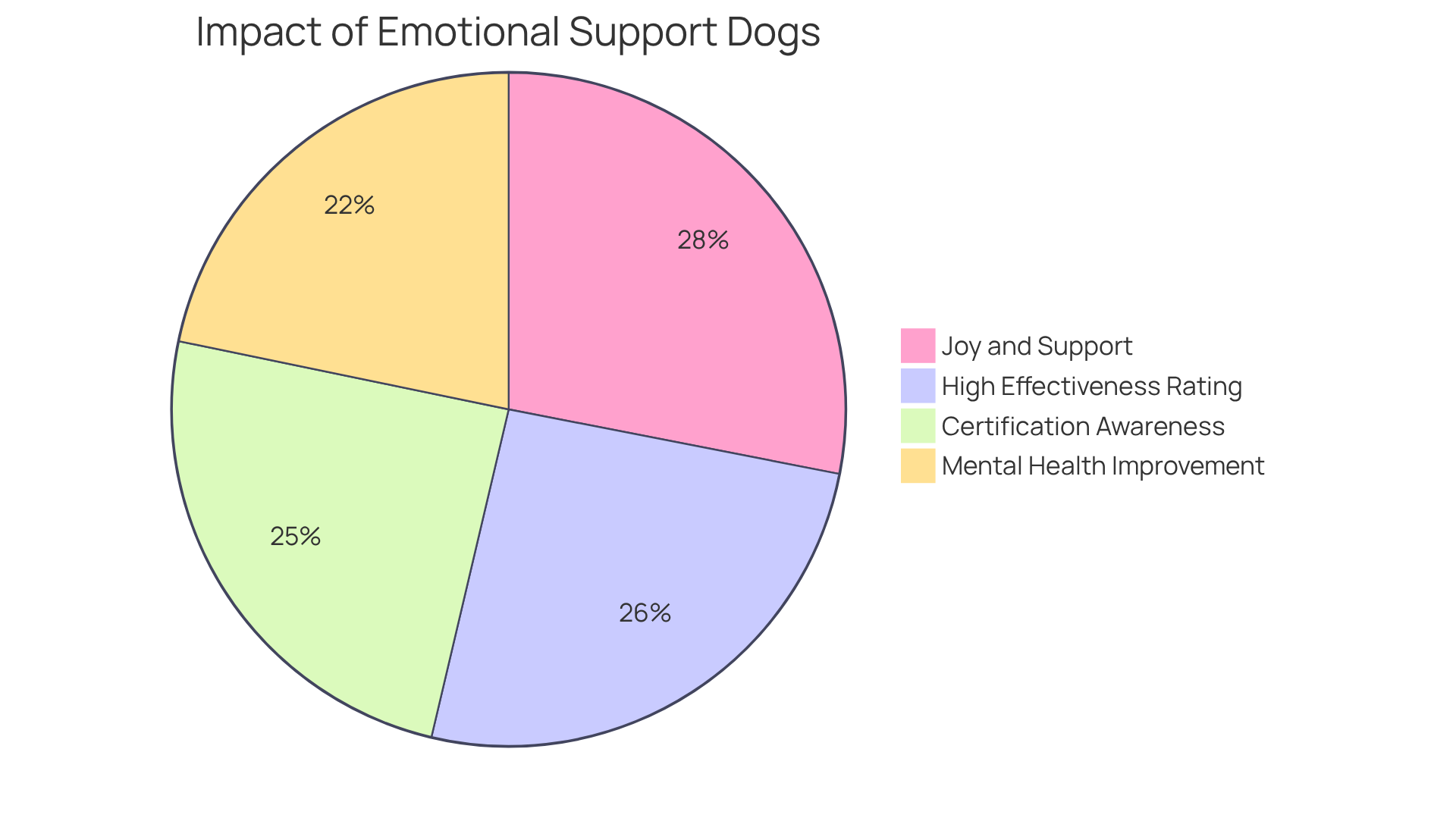

Where Can an Emotional Support Dog Go? Key Rights and Locations
by Lena Park
Last updated: August 2, 2025
Verified and Approved by:
Angela Morris,
MSW, LCSW
Fact Checked

Overview
Emotional support dogs (ESDs) play a vital role in the lives of individuals facing emotional challenges, offering companionship and comfort. These loving animals can access specific locations, such as pet-restricted housing and certain airlines, thanks to important legal protections like the Fair Housing Act and the Air Carrier Access Act.
While ESDs provide essential emotional support and can reside in housing that typically prohibits pets, it’s important to understand that their access to public spaces is more limited compared to service dogs. This distinction can be frustrating, and it underscores the necessity of understanding and advocating for one’s rights in various environments.
Knowing that support is available can be a source of comfort, and obtaining an ESA letter can help ensure that you and your emotional support dog can navigate these challenges together.
Introduction
Navigating the world with an Emotional Support Dog (ESD) can be a source of comfort, yet it also presents complex challenges. For individuals grappling with mental health issues, these invaluable companions offer emotional stability and relief. However, the rights and access associated with ESDs can often be misunderstood, leaving many feeling uncertain.
This guide seeks to illuminate the essential rights and locations where ESDs can accompany their owners. It highlights the legal protections available and the specific environments that recognize their importance.
As more individuals seek the companionship of ESDs, questions naturally arise:
- Where exactly can these dogs go?
- How can their owners effectively advocate for their presence in various settings?
Together, we will explore these concerns, ensuring you feel supported and informed on this journey.
Define Emotional Support Dogs and Their Purpose
Companion animals, known as Emotional Support Dogs (ESDs), provide comfort and psychological stability to those navigating the challenges of mental distress. Unlike service dogs, which are specifically trained to assist individuals with disabilities, ESDs primarily aim to alleviate symptoms associated with anxiety, depression, PTSD, and other mental health conditions. Recent studies reveal that:
- 62% of individuals with emotional support animals experienced improvements in their mental health during the pandemic, emphasizing the significant role these animals play in enhancing emotional well-being.
- 73% of ESA guardians rated their pet’s effectiveness in improving mental health as eight or higher on a scale of one to ten, underscoring their therapeutic value.
The presence of an ESD can be particularly beneficial in various environments, such as housing and travel accommodations, where can an emotional support dog go to assist individuals facing restrictions. Under the Fair Housing Act, those with valid ESA letters can reside in pet-restricted housing, ensuring they have access to the companionship that supports their mental health. Mental health professionals highlight the importance of ESDs in therapeutic settings, noting that animal-assisted interventions can effectively reduce anxiety and depression. Furthermore, 80% of pet guardians feel their animals bring them joy and psychological support, reinforcing the emotional advantages of having pets.
Real-world experiences illustrate the positive impact of ESDs: many individuals share that their dogs help them cope with daily stressors and provide a sense of security. As pet ownership continues to rise, with 73% of households having a pet, the presence of assistance animals among individuals with mental health challenges is increasingly recognized. However, it is essential to acknowledge that:
- 70% of pet owners are unaware of how to get their pet certified as an ESA, highlighting common barriers faced by potential ESA owners.
Understanding the unique role of ESDs is vital for those seeking to embrace their benefits across various aspects of life.

Understand Legal Rights and Regulations for Emotional Support Dogs
For individuals with therapy animals, certain regulations clarify where can an emotional support dog go, providing essential support that allows them to live and travel with their beloved companions. The Fair Housing Act is a significant safeguard, requiring housing providers to make reasonable accommodations for those with emotional support animals (ESAs), even in properties that typically restrict pets. Similarly, the Air Carrier Access Act empowers individuals to understand where can an emotional support dog go on airlines, ensuring their emotional needs are met during journeys.
It’s vital for pet owners to understand these regulations, as this knowledge enables them to advocate effectively for their rights and secure the necessary accommodations. By familiarizing themselves with these protections, individuals can feel more confident and supported in their journey toward emotional well-being.

Identify Specific Locations and Policies for Emotional Support Dogs
Emotional support animals (ESAs) can offer vital companionship and comfort, particularly in housing environments protected by the Fair Housing Act. However, it’s important to recognize that regulations can differ significantly based on location and specific circumstances. Let’s explore where ESAs may be welcomed:
-
Housing is a critical area where support is needed. Under the Fair Housing Act, landlords are generally required to allow emotional support dogs, even in properties that typically prohibit pets, provided that valid documentation is presented. It’s essential to note that while landlords can request documentation for ESAs, they cannot increase rent or refuse to rent to ESA owners. This provision is especially important for individuals who face housing restrictions due to their mental health needs.
-
When it comes to airlines, regulations regarding therapy animals are evolving. As of August 2025, many airlines continue to allow ESAs, but each has its unique set of rules. For instance, some may require advance notice, specific documentation, or even a fee. Travelers should verify their chosen airline’s policies before booking to ensure compliance and avoid any last-minute complications. Staying informed about state-specific laws can empower individuals as they navigate ESA ownership.
-
In public spaces, the situation is different. Unlike service animals, therapy animals do not have the same access rights in places such as restaurants or retail shops. Yet, some businesses may choose to allow ESAs at their discretion. It’s advisable to contact organizations beforehand to confirm their regulations regarding assistance animals.
Understanding these regulations is crucial for those who rely on therapy dogs, particularly in terms of where can an emotional support dog go in a rapidly changing environment. With 18% of pet owners in the U.S. now having assistance animals, and the number of pet owners with ESAs increasing as awareness of their mental health benefits grows, it’s more important than ever to be informed about these rights and regulations. Clear communication and proper documentation are key to navigating these policies effectively, as many experts suggest.
Reflecting on your own experiences with emotional support animals can be a reassuring step in understanding the support available to you.

Troubleshoot Common Issues When Accessing Public Spaces
Entering public areas with an assistance dog (ESD) can present several challenges, often stemming from misunderstandings about rights and regulations. It’s essential to acknowledge the emotional toll this can take on individuals seeking support. Here are some compassionate strategies to navigate these situations:
- Carry Documentation: Always have your ESA letter on hand. This official document, featuring the letterhead and signature of a licensed mental health expert, serves as proof of your need for an assistance animal. It can be invaluable when interacting with property managers or airline personnel, providing reassurance and clarity.
- Communicate Clearly: Be ready to explain the role of your emotional support dog and how it positively impacts your mental health. Clear and concise communication can help alleviate concerns and foster understanding among those who may not be familiar with ESA rights.
- Know Your Rights: Familiarize yourself with the laws protecting ESA owners, such as the Fair Housing Act and the Air Carrier Access Act. Understanding these regulations empowers you to advocate effectively for your rights, especially in situations where your ESD may be questioned. It’s important to recognize where can an emotional support dog go, as ESAs generally do not have the same access privileges as service dogs in public spaces, which is a crucial distinction for effective advocacy.
- Be Respectful: If you encounter a place that does not allow your assistance dog, maintain a composed and courteous demeanor. Consider alternative arrangements or seek out locations where can an emotional support dog go that are more accommodating to ESA participants.
Statistics reveal that misconceptions regarding animal rights for those with emotional needs are prevalent, with many individuals unaware that ESAs do not share the same access privileges as service dogs. For instance, around 18% of pet owners in the U.S. have Emotional Support Animals, highlighting the increasing recognition of their mental health benefits. This distinction is vital for effective advocacy.
Mental health advocates emphasize the importance of proper documentation, noting that having an ESA letter can significantly ease the process of accessing necessary spaces. As Russell Hartstein, a certified dog behavior consultant, observes, “Even if you don’t need a service dog, you could still find a tremendous amount of help from an emotional support animal.” Furthermore, licensed psychologist Aubrey Fine affirms, “The reciprocal relationship that an animal can contribute to the wellness of the human is remarkable,” underscoring the therapeutic value of ESAs and the necessity for clear communication regarding their role.

Conclusion
Emotional Support Dogs (ESDs) are invaluable companions that significantly enhance the mental well-being of individuals grappling with psychological challenges. They provide comfort and stability in various settings, particularly in housing and travel scenarios. It is crucial for individuals to understand their rights concerning ESDs, as this knowledge helps navigate the complexities of where these beloved animals can accompany them, ensuring they receive the emotional support they truly need.
This article highlights essential rights and regulations that protect ESD owners, including the Fair Housing Act and the Air Carrier Access Act. These laws create pathways for access to pet-restricted housing and offer guidelines for traveling with emotional support animals. Moreover, it underscores the importance of having proper documentation and engaging in clear communication to effectively advocate for one’s rights, especially in public spaces where access may be more limited compared to service animals.
Recognizing the therapeutic benefits of Emotional Support Dogs is vital in fostering an inclusive environment for individuals with mental health needs. As awareness of these animals expands, so does the importance of staying informed about rights and the specific locations that accommodate ESDs. Embracing this knowledge empowers individuals to advocate for themselves, ensuring that the presence of these supportive companions is acknowledged and respected in all areas of life.
Frequently Asked Questions
What are Emotional Support Dogs (ESDs)?
Emotional Support Dogs (ESDs) are companion animals that provide comfort and psychological stability to individuals dealing with mental distress. They primarily aim to alleviate symptoms associated with anxiety, depression, PTSD, and other mental health conditions.
How do ESDs differ from service dogs?
Unlike service dogs, which are specifically trained to assist individuals with disabilities in performing tasks, ESDs are not trained for specific tasks but are meant to provide emotional support and comfort.
What evidence supports the effectiveness of ESDs?
Recent studies show that 62% of individuals with emotional support animals experienced improvements in their mental health during the pandemic, and 73% of ESA guardians rated their pet’s effectiveness in improving mental health as eight or higher on a scale of one to ten.
Where can ESDs accompany their owners?
ESDs can assist individuals in various environments, such as housing and travel accommodations. Under the Fair Housing Act, those with valid ESA letters can reside in pet-restricted housing.
What role do ESDs play in therapeutic settings?
Mental health professionals recognize the importance of ESDs in therapeutic settings, noting that animal-assisted interventions can effectively reduce anxiety and depression.
What percentage of pet guardians feel their animals provide psychological support?
Approximately 80% of pet guardians feel that their animals bring them joy and psychological support, highlighting the emotional benefits of having pets.
What common barriers do potential ESA owners face?
About 70% of pet owners are unaware of how to get their pet certified as an ESA, which represents a common barrier for those seeking to obtain an emotional support animal.
Why is it important to understand the role of ESDs?
Understanding the unique role of ESDs is vital for those looking to embrace their benefits in various aspects of life, particularly for individuals facing mental health challenges.
Certify Your Emotional Support Animal Today

Why You Can Rely on Us?
At Wellness Wag, we believe your pet deserves care rooted in both science and compassion. Each article is carefully researched, written in clear language for pet owners, and then reviewed by qualified professionals to ensure the information is evidence-based, current, and practical for real-life care. Our goal is to help you feel confident in making informed decisions about your pet’s health and well-being.
Reviewed by
Angela Morris, MSW, LCSW
Angela is a licensed clinical social worker with 20 years of experience in patient advocacy and community mental health. She has assisted numerous clients with ESA evaluations and brings a deep understanding of disability accommodations, ensuring that all information is accurate, supportive, and practical.

Written by :
Lena Park
Last Updated :
August 2, 2025












